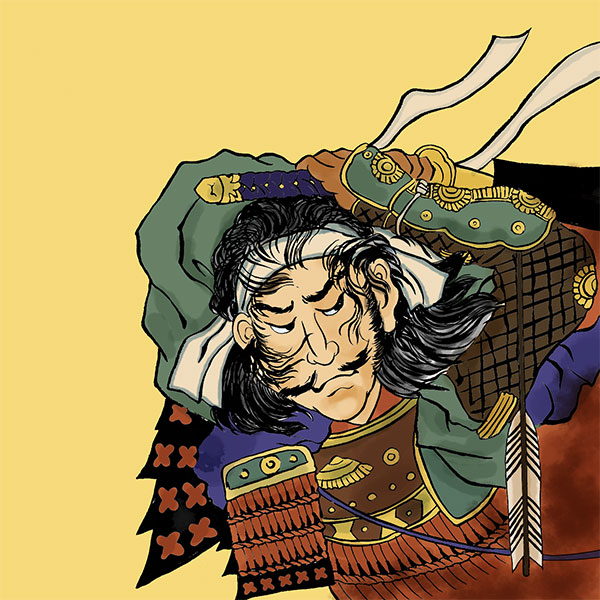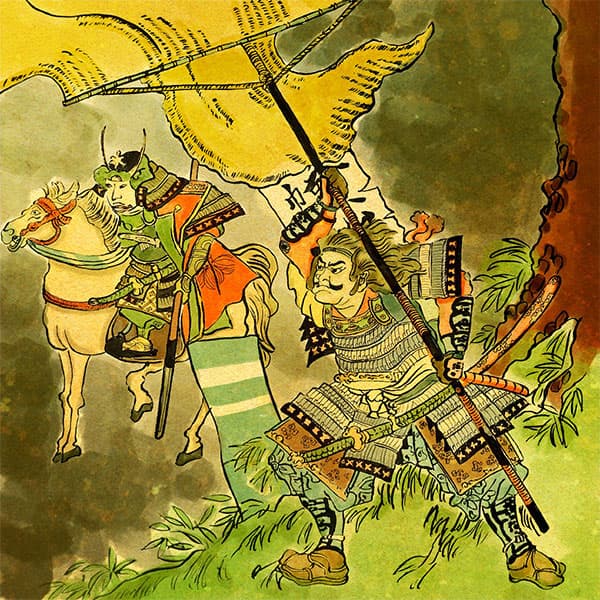Tatsuoki Saito (1/2)The end of the rebellion caused by the viper

Tatsuoki Saito
- Article category
- biography
- name
- Tatsuoki Saito (1548-1573)
- place of birth
- Gifu Prefecture
- Related castles, temples and shrines

Gifu Castle
- related incident
Late Muromachi, a time when order collapsed. It was also a time when people could rise through the ranks based on their ability and become feudal lords, regardless of their origins or status. Isn't Hojo Soun in the Kanto region famous as a pioneer of the Kokujo? Dosan Saito, who became the ruler of Mino Province, is also a representative person. Dosan captured Mino, but his grandson was Tatsuoki Saito. This time, we will look at the life of Tatsuoki Saito, the last head of the Dosan-ryu Saito family.
Dosan-ryu Saito family of Mino Province
During the Muromachi period, Mino Province (present-day Gifu Prefecture) was ruled by the Toki clan as the shugo (lord of the country) and the Saito clan as the shugodai (supporting the shugo).
The man who came to Mino Province was Shogoro Matsunami. Shogoro was an oil seller in Kyoto, but he decided to make a move and became a vassal of Nagahiro Nagai, a vassal of the Toki clan, the shugo (shugo) of the Toki family through Nichiun, the chief priest of Jozaiji Temple in Mino Province. At this time, Shogoro took the name of Nishimura, a vassal of the Nagai family, and called himself Kankuro Nishimura Masatoshi. Shogoro Matsunami, who was an oil seller in Kyoto, served the Nagai family, a vassal of the Toki family in Mino Province, and became Kankuro Nishimura Masatoshi.
In the middle of the Muromachi period, around 1470, when the Onin War broke out, feudal lords from all over the country were fighting over family succession between parents and children and siblings. Similarly, the Toki family had a dispute over the headship of the family between brothers, and Kankuro Nishimura gained the trust of the Toki family during the conflict and rose to prominence. Kankuro Nishimura, who had risen in status, changed his surname to that of the Nagai family he worked for and changed his name to Nagai Bungo.
Matsunami Shogoro came to Mino Province from Kyoto. Shogoro Matsunami became a samurai and became Nagai Bungo, but around 1533 he became ill and handed over the headship of the family to his son Norihide Nagai.
Nagai Bungo's son Norihide Nagai, who took over as head of the family, also rose to prominence in Mino Province. In particular, the battle for succession of the Toki family in Mino Province continued, and Norihide Nagai took advantage of this. Around 1538, he changed his surname from Nagai to Saito and took the name Toshimasa Saito, after the Saito clan, the governor of Mino Province. From around 1541, Toshimasa Saito poisoned and expelled the Toki clan, the shugo, and effectively became the national shugo of Mino Province. Around 1548, he changed his name from Toshimasa Saito to Dosan Saito. This was the invasion of Mino Province by Dosan Saito, and the beginning of the Dosan school of the Saito family.
The upheaval of Mino Province carried out by two generations, Shogoro Matsunami and Dosan Saito. However, because Mino Province was taken by force, the political situation was unstable. It is said that Dosan Saito's eldest son, Yoshitatsu Saito, was the son of the exiled Toki family, and that Dosan Saito and Yoshitatsu Saito gradually fell out of favor. The samurai of Mino Province, who were dissatisfied with Dosan's upheaval, supported Yoshitatsu Saito, and Dosan retired. However, the conflict between Dosan and Yoshitatsu remained unresolved, and in 1556 a battle erupted, the Battle of Nagara River. Saito Dosan was killed in this battle. In this way, Mino Province was ruled by Yoshitatsu Saito, who won the battle of Nagara River. Tatsuoki Saito was born as Yoshitatsu's son.
Tatsuoki's birth and family succession
Tatsuoki Saito was born in Mino Province in 1548 or 1549, and his childhood name was Kitaro. My mother was Yoshitatsu Saito's legal wife, Omi. Omi is said to be the daughter of Hisamasa Asai, the head of the Kita Omi Asai family, but since Hisamasa and Omi are only one year apart in age, she is the daughter of Hisamasa Asai's father Ryomasa Asai. It is believed that she became Hisamasa's adopted daughter and then married Yoshitatsu Saito. In other words, from his father's perspective, Tatsuoki Saito was Dosan Saito's grandson (if Dosan and Yoshitatsu really had a father-son relationship), and from his mother's perspective, he was related to Asai Nagamasa as cousins. Become.
When Yoshitatsu was eight years old, the Battle of Nagaragawa, fought between his father Yoshitatsu and his grandfather Dosan, took place. From then on, his father Yoshitatsu became the head of the Mino Province, and there were frequent conflicts between Nobunaga Oda, who had risen up in Owari Province (present-day Aichi Prefecture), and Mino and Owari.
However, in 1561, when Tatsuoki Saito was 14 years old. When his father, Yoshitatsu, passed away due to illness, he took over as the head of the family and the national governor of Mino Province.
However, the Saito family, the Dosan school, had conquered Mino Province in two generations, Shogoro Matsunami and Dosan Saito. Moreover, Dosan and Yoshitatsu had also fought the Battle of Nagara River, and the political situation was unstable. The 14-year-old Ryuko rules such a country, but he lacks the power. Therefore, Tatsuoki made important use of Saito Hida no kami. However, Saito Hida no kami, who was trusted, had a bad reputation among those around him and was unable to gain the trust of his vassals. The samurai of Mino Province (Mori Yoshinari, Sakai Masanao, Hori Hideshige, Saito Toshiharu, Akechi Mitsuhide, etc.) abandoned Mino Province and the Saito family and fled to the Oda family and other countries with which they were in conflict. Tatsuoki Saito became the ruler of the country at a young age, but was forced to manage the territory in a difficult manner.
Takeover of Inabayama Castle and Takenaka Hanbei
With Saito Tatsuoki becoming the new ruler, Mino Province became politically unstable.
In 1561, the Saito family of Mino Province was attacked by Oda Nobunaga of Owari Province. This battle was a victory for the Saito family, but the Saito family lost a senior vassal. Also, in 1562, Endo Morikazu, the lord of Gujo Hachiman Castle and a powerful vassal, died of illness.
Wanting to make a comeback, Tatsuoki Saito tried to form an alliance with the Azai family in Kita-Omi, which was also his mother's family home, but the Oda family overtook him and the Oda family and the Azai family became allies. Therefore, Tatsuoki formed an alliance with the Rokkaku family of Minami-Omi, which had long-standing ties with the Saito family, in an attempt to compete against them.
Meanwhile, in 1563, Oda Nobunaga invaded Mino Province. This battle (Battle of Shinkano) was fought by Shigeharu Takenaka (Hanbei Takenaka) and ended in victory for the Saito family.
However, the following year, the 7th year of Eiroku (1564). Shigeharu Takenaka, who had a personal grudge against Hida no kami Saito, who supported Tatsuoki Saito, killed Hida no kami in broad daylight along with his father-in-law, Morinari Ando, who was one of the Nishi Mino Sanjinshu. Saito Tatsuoki lost his residence, Inabayama Castle, and fled to Ukaiyama Castle and then Yumukaiyama Castle. This life on the run lasted for half a year. Six months after Inabayama Castle was captured, Tatsuoki is said to have had it returned to him by Shigeharu Takenaka and Morinari Ando, or it is said that Tatsuoki Saito took it back with the help of forces supporting Tatsuoki. However, the sun was setting for the Saito family in Mino Province for all to see.
Oda Nobunaga's invasion
Oda Nobunaga began his invasion of Mino Province in earnest around the time of Saito Yoshitatsu's death from illness. At first, they used force through battle, but at the same time they built Komakiyama Castle to secure the bridgehead. Furthermore, the Toyama clan, who were the lords of Iwamura Castle in Higashi Mino (currently a castle in Ena City, Gifu Prefecture), were related to the Oda family, so it was an area where the Oda family had a strong influence. Centered around this Endo family, the Ichihashi clan, Maruke clan, Takagi clan, and other Kokujin clans in Higashi Mino switched sides and took control of Higashi Mino.
Of Mino Province, East Mino fell to the Oda family.
In 1565, Tadayoshi Sato, the lord of Kajida Castle (currently located in Tomika-cho, Kamo-gun, Gifu Prefecture), which had fallen to the Oda family, was defeated by Nobuchika Kishi, a kokujinshu on the side of the Saito family. I will defeat you. In this battle, Tatsuoki's great-uncle, Michitoshi Nagai, was defeated by Toshiharu Saito (the youngest son of Dosan Saito), who was a military commander of the Oda family, and the Chuno region also came under the influence of the Oda family.
The Chuno region of Mino Province also fell to the Oda family. Tatsuoki Saito, who had lost most of Mino to the Oda family, approached the Ashikaga shogun family in Kyoto and tried to make a comeback.
However, in the 10th year of Eiroku (1567), the Nishi Mino Sannin (Yoshimichi Inaba, Naomoto Ujiie, Morinari Ando), who were influential Kokujin in Mino Province, responded to the Oda family, and Tatsuoki Saito became a member of the Inaba clan. I ran away from Yamashiro. Tatsuoki became the national governor of Mino Province at the age of 14, and left Mino Province at the age of 20. However, Tatsuoki never returned to Inabayama Castle.
This marked the end of the ascendancy of the Saito family of the Dosan school, which began with Shogoro Matsunami and continued with Dosan Saito, Yoshitatsu, and Tatsuoki. However, Tatsuoki Saito wanders around the country in an attempt to restore power.
Escape to Ise Nagashima
On August 15, 1567, Saito Tatsuoki escaped from Inabayama Castle with his vassals and left Mino Province by boat down the Kiso River below the castle. Tatsuoki's destination was Kawachi-Nagashima, Ise Province. The Oda army also invaded Kitaise in order to capture Tatsuoki.
- related incident

- WriterTomoyo Hazuki(Writer)I have loved history and geography since my student days, and have enjoyed visiting historical sites, temples and shrines, and researching ancient documents. He is especially strong in medieval Japanese history and European history in world history, and has read a wide range of things, including primary sources and historical entertainment novels. There are so many favorite military commanders and castles that I can't name them, but I especially like Hisashi Matsunaga and Mitsuhide Akechi, and when it comes to castles, I like Hikone Castle and Fushimi Castle. Once you start talking about the lives of warlords and the history of castles, there's a side of you that can't stop talking about them.




